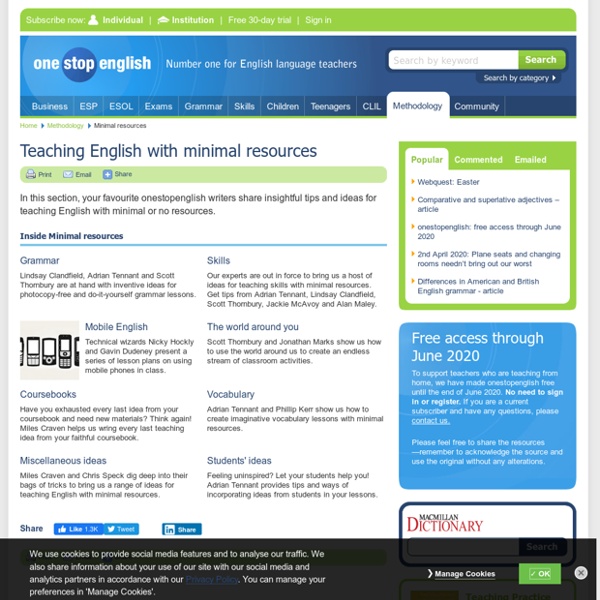



http://www.onestopenglish.com/methodology/minimal-resources/
Related: esl • collection linksLove Stories for Learners in Simple English (Stories, Glossary, Exercises, Answer Key) Here you can find beautiful stories in simple English for you to read, download and practice. Read interesting stories and improve your English at the same time. Click Here for Step-by-Step Rules, Stories and Exercises to Practice All English Tenses The following stories are suitable for students at an advanced reading level. Each story comes with the following sections: Story Glossary Exercises Fill in the blanks Vocabulary questions Grammar questions Comprehension questions Essay questions Full answer key
Crazy animals and other activities for teaching young learners It brings together the experience and expertise of teachers from around the world to provide a range of stimulating and exciting classroom activities for the primary classroom. There are 50 tried and trusted activities which have been refined and improved over the years by teachers working in diverse contexts and environments. Children will enjoy practising their English through these stimulating and motivating activities.
Smartphones & Learning possibilities in the EFL class Some data on mobile usage growth 21st century classroom infographic Six hours a day. Dogme Skip to content Dogme is an approach to teaching that argues that teaching should focus on the learner and not be driven by the resources available, including course books. It is a recent movement in ELT, started by a group of teachers who are against 'resource heavy' teaching, arguing that if learners are not interested they will not learn and therefore all material should be generated by the learners and the lessons directed by them, rather than the teacher. ExampleLearners come to class discussing something that is in the news. The teacher encourages and facilitates discussion and provides answers to questions about grammar and vocabulary as they arise. In the classroomIn a Dogme lesson, the classroom as such does not exist, as there are no resources, course books or lesson structures apart from those that learners bring.
25 ideas for using WhatsApp with English language students Philip Haines is the Senior Consultant for Oxford University Press, Mexico. As well as being a teacher and teacher trainer, he is also the co-author of several series, many of which are published by OUP. Today he joins us to provide 25 engaging and useful classroom activities for language learners using WhatsApp. Teaching without a coursebook What's wrong with using a coursebook?A topic-based syllabusStructuring the courseNeeds analysisSet short-term objectivesRemedial grammarError correctionVarietyConclusion What's wrong with using a coursebook?Well, in many cases, nothing!
6 Excellent Free Sites to Practise Reading Comprehension It’s been too long since I’ve written about improving reading skills. Last time I posted about sites to help you practise reading comprehension was in May last year. Way too long. The image in English Language Teaching Each of these leading experts provide insightful articles and practical ideas for using still and moving images in language education. The list of contributors include Ben Goldstein, Anna Whitcher, Antonia Clare, Paul Driver, Sylvia Karasthati, Paul Dummett, Magdalena Wasilewska, Andreia Zakime, Elena Domínguez Romero, Jelena Bobkina, Candy Fresacher, Tyson Seburn, Chrysa Papalazarou, Magdalena Brzezinska, Emma Louise Pratt, Samantha Lewis, Jean Theuma, and Valéria Benévolo França who are all also members of the Visual Arts Circle, a collective which provides a wide range of resources for you to use and encourages discussion and debate around the use of images in language teaching. The book includes a preface by Gunther Kress, Professor of Semiotics and Education in the Department of Culture, Communication and Media Within the Institute of Education of University College London. It is available by open access thanks to the support of the ELT Council. Download this publication below.